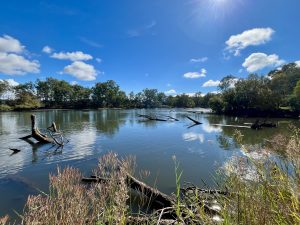With the warmer weather our cold-blooded friends are out and about again, so be careful where you walk!
Snakes have their special place in the web of the Box-gum grassy woodland ecosystem, and their presence is commonplace in the warmer months in our regional bush parks.
It is in all of our interests to simply stop when encountering a snake; stand still and let them pass. A snake will always depart if given the chance, they are protected by law and of course, they carry their own very effective protection against threat!
Here are the three you are most likely to encounter in our area.
Red-bellied black snake (Psuedechis porphyriacus)
Pictured above, these snakes are commonly seen close to dams, creeks and other bodies of water. The red-bellied black is easily identified by its distinctive colouring; glossy black with a light pink to brilliant red belly.
The red bellied black snake is most active by day. When not hunting or basking it retires beneath timber, rocks and rubbish or down holes. It’s diet is primarily frogs, but it also preys on reptiles, small mammals and the young of other snakes.
Although dangerously venomous, bites are rare from this placid and fairly docile snake. If provoked, it will enact a lengthy bluff display with hisses and flattened neck, then try to escape at the first opportunity. The bite of a red-bellied black snake is rarely life-threatening as they usually inject little toxin, however a bite still requires immediate medical attention.
Eastern brown or Common brown snake (Pseudonaja textilis)
The brown snake has a slender body and variable colour ranging from uniform tan to grey or dark brown. Some young brown snakes have stripes and are often confused with tiger snakes. A large adult brown snake may exceed two metres in length.
Brown snakes are active during the day, hunting for small mammals, particularly rodents. They will also eat frogs, small birds, eggs, and even other snakes. Because of their preference for introduced rats and mice brown snakes are often found around human habitation.
Browns are notorious for their speed and aggression. When highly agitated, they hold their necks high, appearing in an upright S-shape. The snake usually tries to flee when confronted, though it can be highly defensive if provoked.
The brown snake is by far the most common cause of snakebite in our area. Their venom causes diarrhea, dizziness, collapse or convulsions, renal failure, paralysis and cardiac rest. Without medical treatment, bites can be fatal.
Tiger snake or Mainland Tiger snake (Notechis scutatus)
Tiger snakes are highly variable in appearance, not always displaying the distinctive tiger stripes suggested by its name. The body can also be grey, olive-brown or almost black. Tiger snakes are relatively short and stout bodied with a broad head. Commonly 1.2-1.6m in length, particularly large animals may exceed 2m.
Tiger snakes are common near swamps, wetlands and water courses, as frogs are their main diet. They will also eat lizards, birds, small mammals and fish. These snakes are tolerant of lower temperatures than brown and black snakes, and in hot weather often hunt at night.
Tiger snakes put on an impressive threat display before attempting to bite; flattening their body and raising their head, they hiss loudly and follow up with mock strikes.
The bite is highly venomous. Symptoms include localized pain in the foot and neck region, tingling, numbness, and sweating, followed by a fairly rapid onset of breathing difficulties and paralysis.
Parklands Rangers always have snake bandanges on hand while working the parks in spring and summer, and maintain their knowledge of how to treat snake-bite. We encourage users of the regional parks to brush up on your first aid knowledge annually – it could save a life in the bush.





